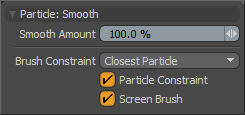The Particle Tools ('Smooth', 'Smudge', 'Move', 'Pinch', 'Tangent Pinch', 'Spin' & 'Flatten') are meant as a way to modify particle positions within a point cloud. Much like the sculpt tools are for shaping surfaces, the particle tools allow users to control, position and direct their particles, even individually, to produce the desired results. Particles can be any number of things, a Mesh layer with single point vertices or a collection of single point polygons (also called 'point clouds'). While there are a number of ways users could approach the creation of a point cloud - the most direct would be the use of the 'Particle Paint' tool. Note that the Particle tools cannot be used to modify procedurally generated particles such as those of the 'Particle Cloud' or 'Particle Generator' items.
Using the Tool
The Particle Tools are found in the 'Paint' interface tab, under the 'Particle Tools' subtab of it's toolbox. Upon selecting the tool, its attributes appear in the tool properties viewport. When first selected, the tool will also automatically select the brush tip, by default the 'Smooth Brush'. Users can select one of the alternate brush tips before proceeding or RMB+click in the 3D viewport to interactively scale the brush size. Users can then simply LMB+click and drag in the viewport to affect the particles. The Flatten tool will gather particles toward the brushes center, the speed at which they move is dependant on the 'Flatten Amount'. Pressing and holding down the 'Ctrl' key will negate the affects of the tool, spreading the particles outward, away from its center.
Particle Smooth--
 Flatten Amount: Controls the strength of the 'Smoothing' which is essentially the speed at which the affected particles will move inward or outward.
Flatten Amount: Controls the strength of the 'Smoothing' which is essentially the speed at which the affected particles will move inward or outward.
Brush Constraint: When painting into a volume of particles from a 2D viewport (you can only view the 3D elements in the flat 2D space of the screen), the 'Brush Constraint' options control what area within the volume is affected by the Brush-
Closest Particle-- Affects the particle(s) closest to the viewport camera (closest to the viewer).
Grid-- Affects the particle(s) closest to the Work Plane grid.
Center Particle-- Affects the particle(s) closest to the center of the volume under the brush.
Particle Constraint: When the 'Particle Constrain' option is enabled, each individual vertex is constrained against any foreground polygons ensuring it is always resting on its surface as it moves. Work in the same manner as the 'Constrain to Background' - 'Point' mode, but is not dependant upon background geometry.
Screen Brush: When particle painting, the volume of the brush tip in 3D space is a fixed size and will only affect the particles within this volume (as defined by the 'Brush Constraint' option), particles that are further away in the volume will not be affected even though the brush is passing over them. Enabling the 'Screen Brush' option will virtually flatten the particle volume so that all particles through the volume will be affected by the brush, regardless of how close or distant they are.
TIP: When working with the 'Particle Constraint' option, constraining geometry doesn't necessarily have to be in the same layer as the point cloud. Users can hold down the 'Ctrl' key and select additional Item layers, bringing them into the foreground. The edited particles will conform to the foreground polygons surface but remain within their initial layer.


